In Hawaii, the vibrant backyard ecosystem is graced by a myriad of avian inhabitants, comprising a total of 17 distinct bird species.
From the captivating melodies of the Northern Mockingbird to the tropical hues of the Rose-ringed Parakeet, each species brings its unique charm to the Hawaiian landscape.
This collection of 17 backyard birds encompasses a blend of native and introduced species, creating a harmonious coexistence that defines the avian diversity of the islands.
Join us on a virtual journey as we delve into the fascinating world of Hawaii’s backyard birds, exploring their behaviors, habitats, and the intricate ecological web they contribute to in this Pacific paradise. So, stay focused.
17 Backyard Birds of Hawaii
Get to know the diverse avian residents of Hawaii, where introduced and native bird species coexist in a unique blend of ecosystems.
The islands boast a rich tapestry of feathered inhabitants, from melodious songbirds like the Northern Mockingbird to ground-dwelling quails and colorful munias. Explore the distinctive characteristics and adaptability of these fascinating birds.
1. House Finch
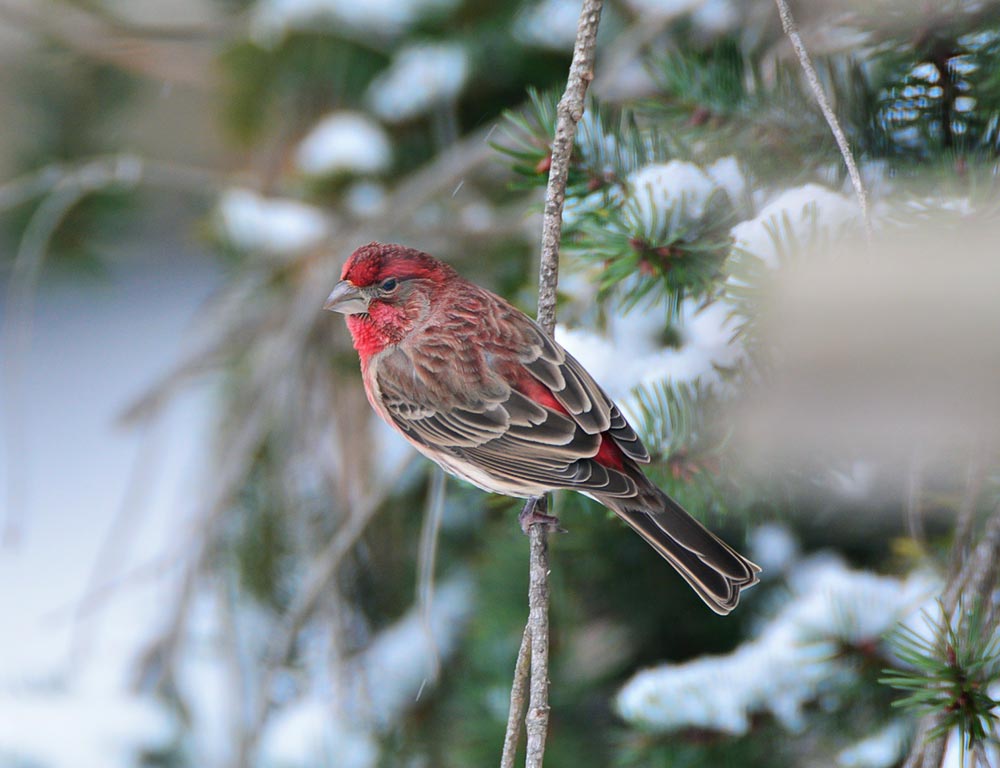
- Scientific Name: Haemorhous mexicanus
- Population: Abundant
- Life Span: 3-5 years
- Size: 5-6 inches
- Weight: 0.6-1 ounce
- Wingspan: 8-10 inches
- Status: Common
The House Finch, scientifically known as Haemorhous mexicanus, is familiar in Hawaiian backyards. With an abundant population, these birds have adapted well to human environments.
Typically measuring between 5 and 6 inches in length and weighing around 0.6 to 1 ounce, House Finches display a colorful plumage, with males featuring vibrant red markings on their heads and throats. Their wingspan ranges from 8 to 10 inches.
House Finches are known for their adaptability and can be found in various habitats, including urban areas, gardens, and parks. Their diet consists mainly of seeds, fruits, and insects.
With an average lifespan of 3 to 5 years, these social birds are often seen in flocks, especially during breeding. They build cup-shaped nests in shrubs and trees, using both natural and artificial structures.
2. Northern Cardinal
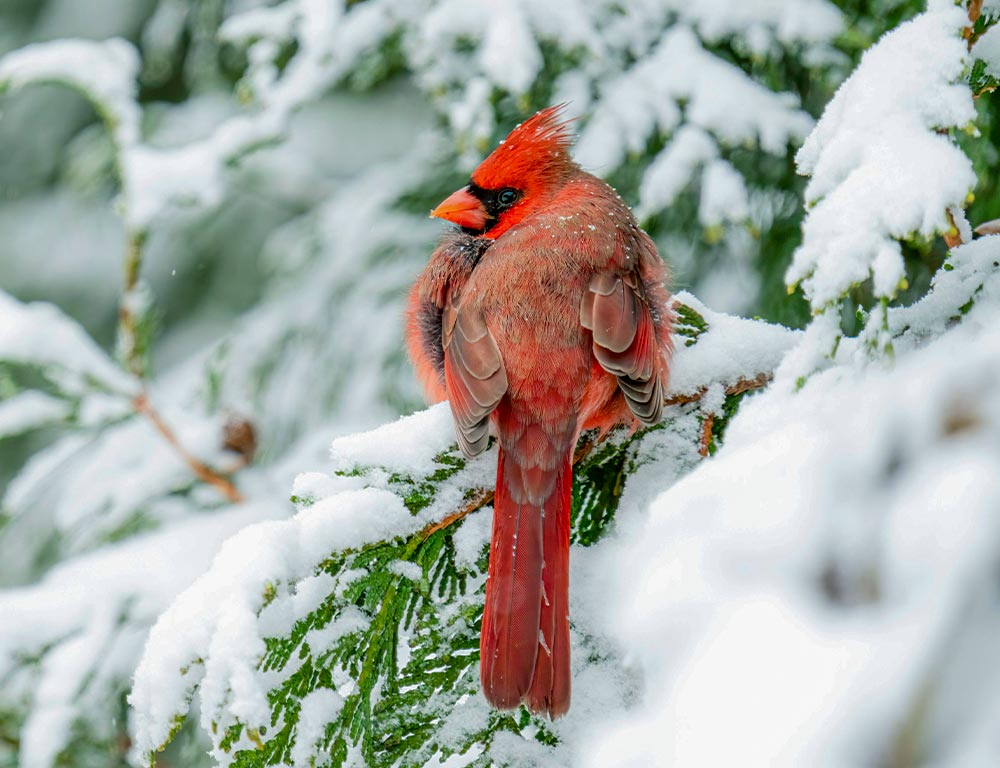
- Scientific Name: Cardinalis cardinalis
- Population: Common
- Life Span: 3 years
- Size: 8-9 inches
- Weight: 1.5-1.7 ounces
- Wingspan: 10-12 inches
- Status: Introduced
The Northern Cardinal (Cardinalis cardinalis) is a common bird species in Hawaii, despite being introduced to the islands. With a striking appearance, the male Northern Cardinal boasts bright red plumage, while the female displays a more subdued brown color with red accents.
These birds are relatively small but easily distinguishable, Measuring 8 to 9 inches in length, with a wingspan of 10 to 12 inches. Weighing between 1.5 to 1.7 ounces, Northern Cardinals primarily feed on seeds, fruits, and insects. Their average lifespan is around three years.
Although they were not native to Hawaii, Northern Cardinals have successfully adapted to the local environment.
They are often found in gardens, parks, and open woodlands. Their strong, conical beaks are adapted for cracking seeds, and their melodic songs are a common feature of Hawaiian landscapes.
3. Common Myna
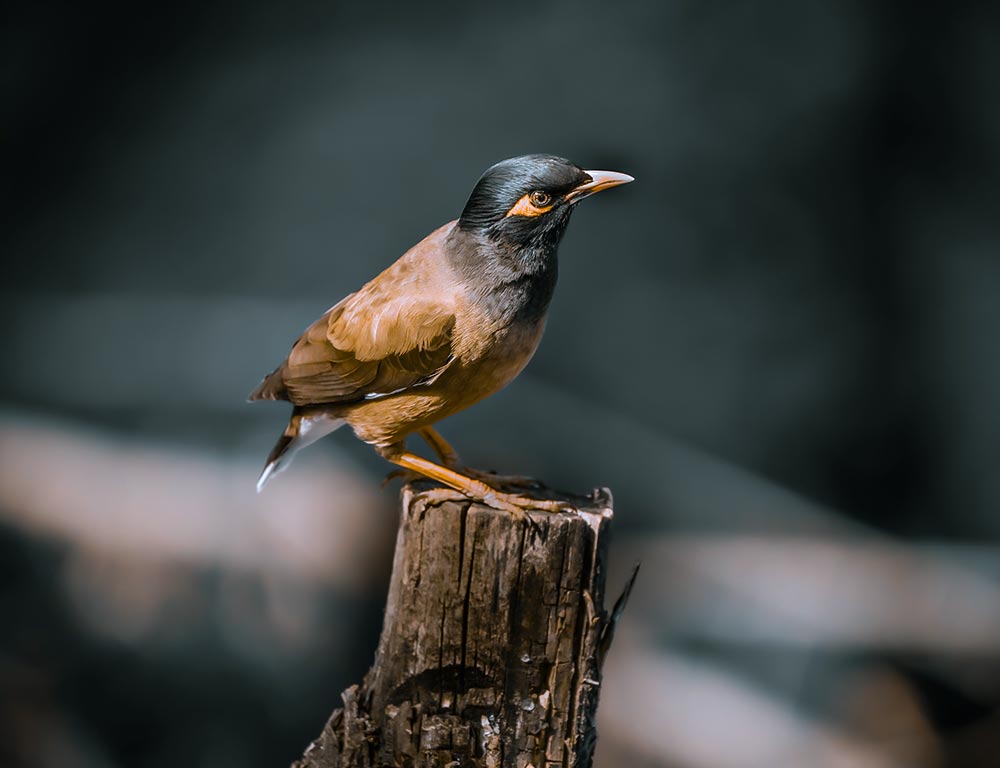
- Scientific Name: Acridotheres tristis
- Population: Abundant
- Life Span: 5-7 years
- Size: 9-10 inches
- Weight: 6-8 ounces
- Wingspan: 15-18 inches
- Status: Introduced
The Common Myna (Acridotheres tristis) is a widespread bird in Hawaii, despite being introduced to the islands. With an abundant population, these birds have adapted well to urban and suburban environments.
Measuring 9 to 10 inches in length and weighing 6 to 8 ounces, the Common Myna is a medium-sized bird with brown body plumage, a yellow eye patch, and bright yellow legs. Their wingspan ranges from 15 to 18 inches.
Common Mynas are known for their gregarious nature, often forming noisy flocks. They have a diverse diet, feeding on fruits, insects, and human food scraps.
Their adaptability to various habitats and omnivorous diet contribute to their success in Hawaii. These intelligent birds are known for their ability to mimic human speech and other sounds, making them popular but sometimes challenging backyard visitors.
4. Java Sparrow
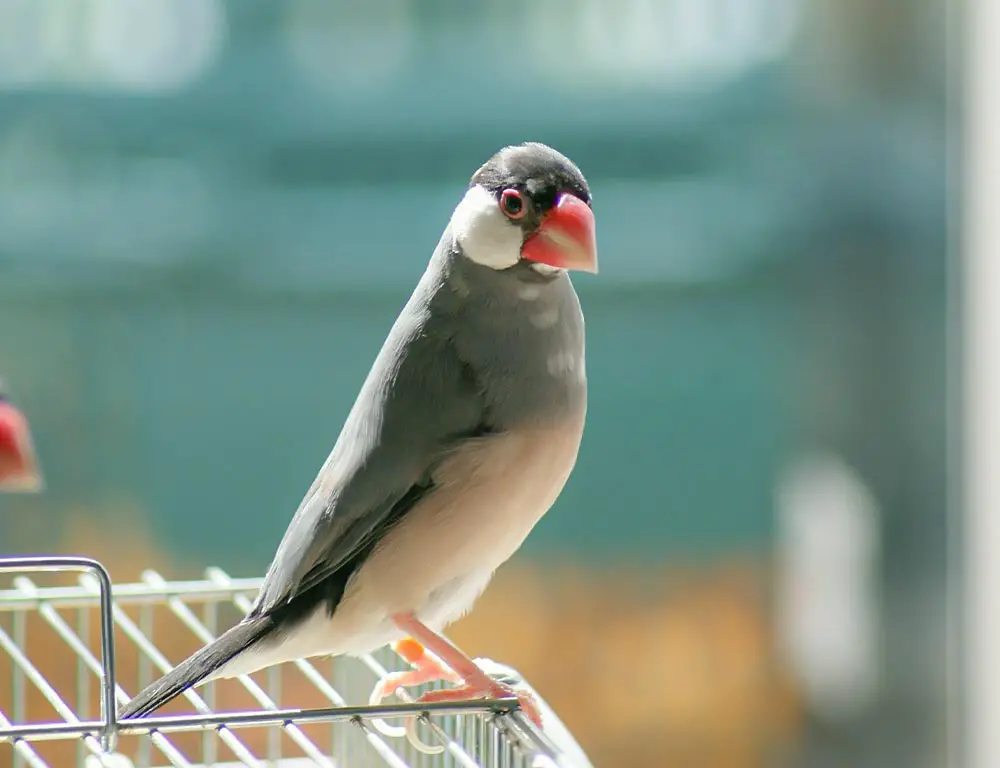
- Scientific Name: Lonchura oryzivora
- Population: Established
- Life Span: 7-8 years
- Size: 5-6 inches
- Weight: 0.8-1.2 ounces
- Wingspan: 7-8 inches
- Status: Introduced
The Java Sparrow (Lonchura oryzivora) is an established bird species in Hawaii, having been introduced to the islands.
With a population that has successfully adapted to the local environment, Java Sparrows are often found in open habitats, including grasslands and agricultural areas.
Java Sparrows are small, compact birds with a distinctive appearance, measuring 5 and 6 inches long and weighing between 0.8 and 1.2 ounces. They feature a grayish-brown body, pink legs, and a conical, silver beak. Their wingspan ranges from 7 to 8 inches.
Java Sparrows are social birds that typically forage in flocks. Their diet includes a variety of seeds, grains, and small insects. With a lifespan of 7 to 8 years, these birds are known for their resilience and adaptability.
While they may not be native to Hawaii, their established presence highlights their ability to thrive in different environments.
5. Red-crested Cardinal
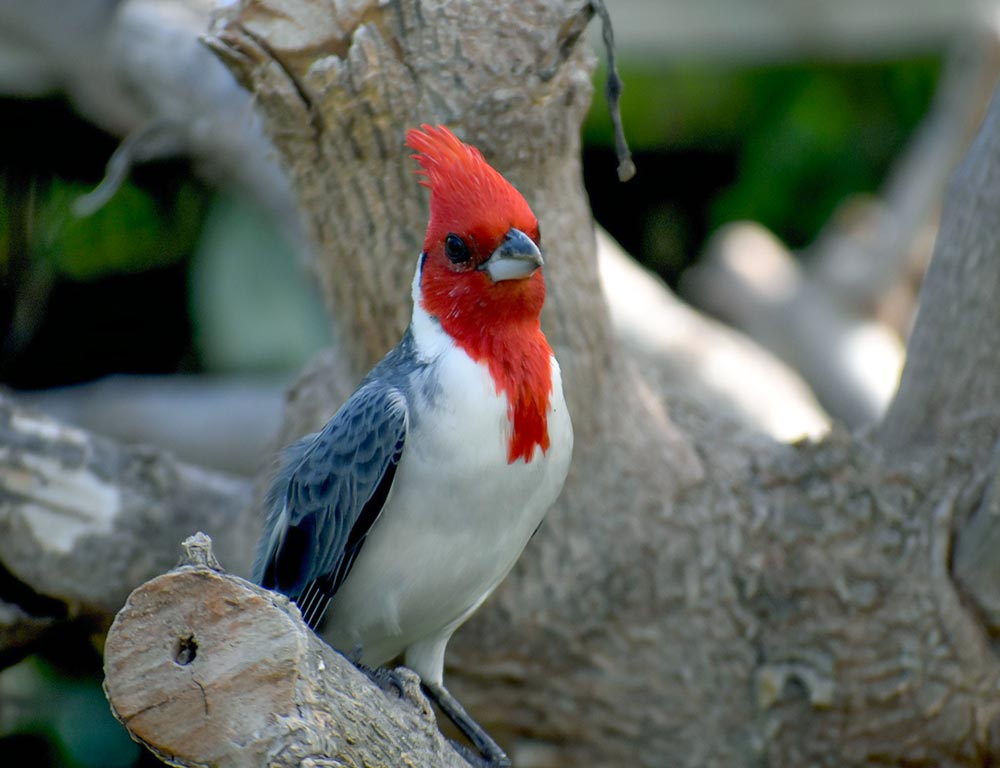
- Scientific Name: Paroaria coronata
- Population: Introduced
- Life Span: 4-5 years
- Size: 8-9 inches
- Weight: 1.5-2 ounces
- Wingspan: 10-12 inches
- Status: Introduced
The Red-crested Cardinal (Paroaria coronata) is a bird species introduced to Hawaii and recognized for its vibrant plumage. With a population established in the islands, these birds have become common in various habitats, including gardens and urban areas.
Measuring between 8 and 9 inches in length and weighing between 1.5 and 2 ounces, the Red-crested Cardinal is a medium-sized bird with a striking appearance.
It features a bright red crest on its head, contrasting with its white and gray body. Their wingspan ranges from 10 to 12 inches.
Red-crested Cardinals primarily feed on seeds, fruits, and insects. They are known for their melodic calls, often found in pairs or small groups.
With a 4 to 5 years lifespan, these birds have successfully adapted to the Hawaiian environment, adding a splash of color to the local birdlife.
6. Spotted Dove
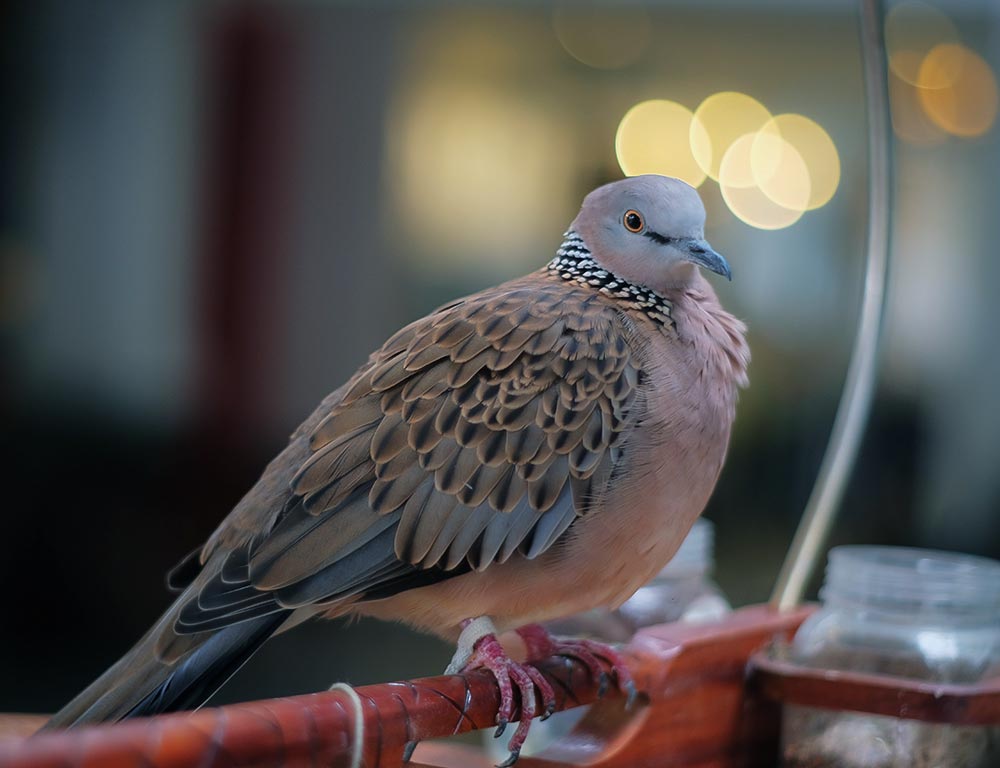
- Scientific Name: Spilopelia chinensis
- Population: Introduced
- Life Span: 5-7 years
- Size: 11-13 inches
- Weight: 4-6 ounces
- Wingspan: 17-18 inches
- Status: Introduced
The Spotted Dove (Spilopelia chinensis) is an introduced bird species in Hawaii, known for its gentle cooing calls and mottled plumage.
With an established population, these doves are commonly found in various environments, including urban areas and agricultural lands.
Measuring between 11 to 13 inches in length and weighing between 4 and 6 ounces, spotted doves are medium-sized birds with a soft, spotted pattern on their feathers. Their wingspan ranges from 17 to 18 inches.
Spotted Doves primarily feed on seeds, grains, and small insects. They are often seen foraging on the ground and can form large flocks. .
With a lifespan of 5 to 7 years, these doves have adapted well to the Hawaiian climate, contributing to the diverse avian community.
7. Zebra Dove
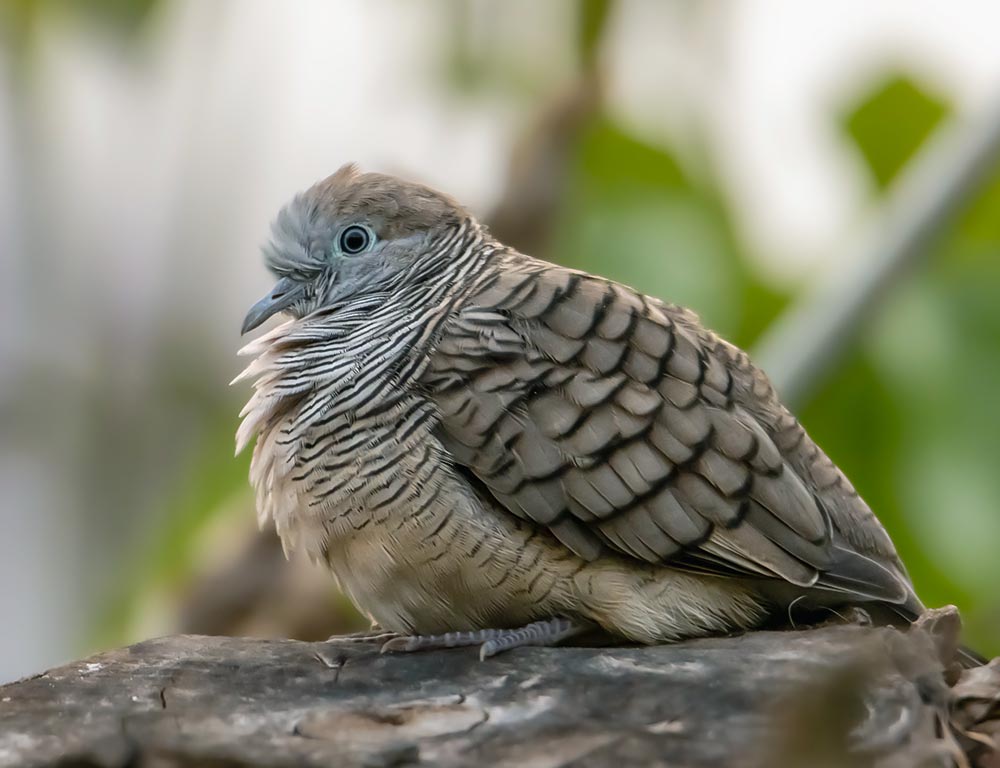
- Scientific Name: Geopelia striata
- Population: Native
- Life Span: 5-10 years
- Size: 8-9 inches
- Weight: 2-3 ounces
- Wingspan: 12-14 inches
- Status: Native
The Zebra Dove (Geopelia striata) is a native bird species in Hawaii, recognized for its distinctive striped plumage. With a stable population, these doves are commonly found in various habitats, including forests, gardens, and urban areas.
Measuring 8 and 9 inches in length and weighing 2 and 3 ounces, zebra doves are small, ground-dwelling birds with a zebra-like pattern on their feathers. Their wingspan ranges from 12 to 14 inches.
Zebra Doves primarily feed on seeds and grains, foraging on the ground for their food.
They are often seen in pairs or small groups and are known for their soft, repetitive cooing calls. With a lifespan of 5 to 10 years, these native doves play a role in the natural balance of Hawaii’s ecosystems.
8. Red-vented Bulbul
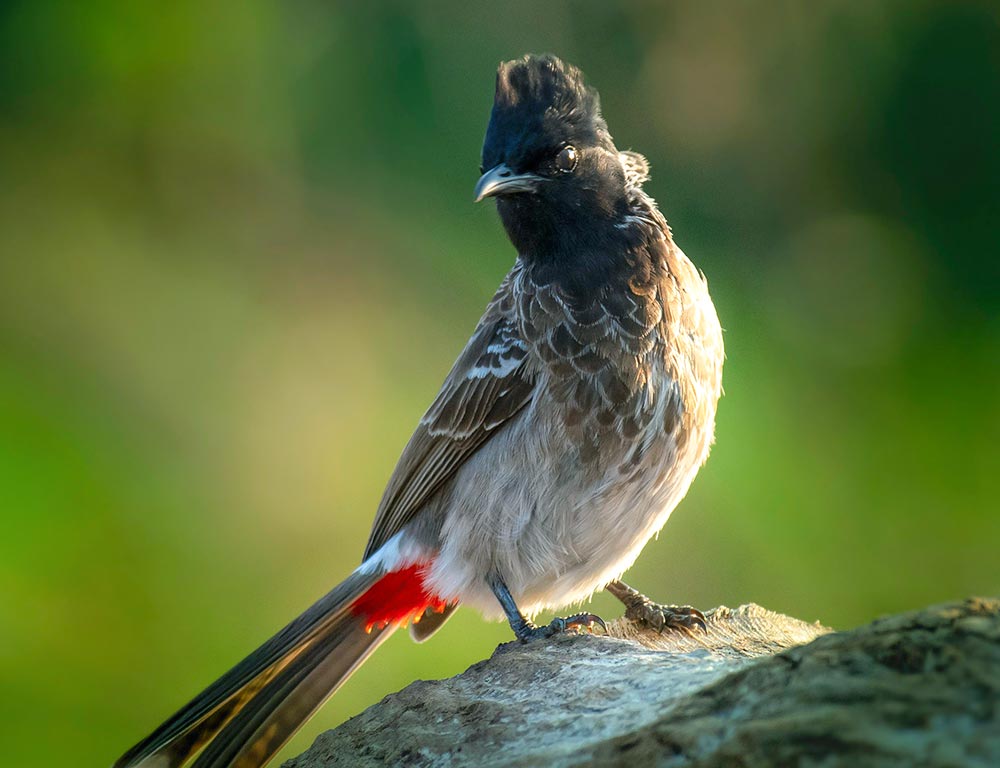
- Scientific Name: Pycnonotus cafer
- Population: Introduced
- Life Span: 7-10 years
- Size: 8-9 inches
- Weight: 1.5-2 ounces
- Wingspan: 11-12 inches
- Status: Introduced
The Red-vented Bulbul (Pycnonotus cafer) is an introduced bird species in Hawaii, recognized for its distinctive call and colorful plumage.
With an established population, these bulbuls are commonly found in various habitats, including gardens, parks, and wooded areas.
Measuring between 8 to 9 inches in length and weighing between 1.5 to 2 ounces, red-vented bulbs are medium-sized birds with brownish bodies, red under tail coverts, and a pointed crest on their heads. Their wingspan ranges from 11 to 12 inches.
Red-vented Bulbuls have an omnivorous diet, feeding on fruits, insects, and nectar. They are known for their lively and melodious calls.
With a lifespan of 7 to 10 years, these introduced birds have adapted well to the Hawaiian environment, contributing to the diverse birdlife in the region.
9. White-rumped Shama
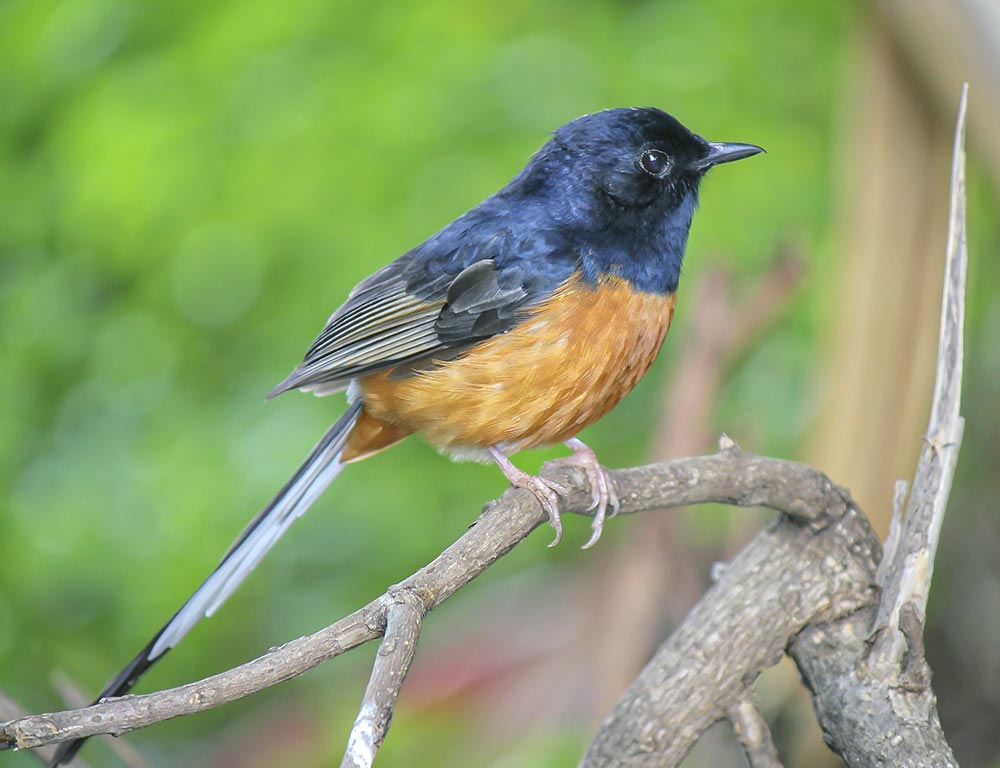
- Scientific Name: Copsychus malabaricus
- Population: Introduced
- Life Span: 6-10 years
- Size: 8-9 inches
- Weight: 1.5-2 ounces
- Wingspan: 10-12 inches
- Status: Introduced
The White-rumped Shama (Copsychus malabaricus) is a bird species introduced in Hawaii, celebrated for its melodious songs and striking plumage.
With an established population, these shamas are commonly found in various habitats, including gardens, parks, and forested areas.
Measuring 8 to 9 inches in length and weighing 1.5 to 2 ounces, White-rumped shamans are medium-sized birds with a black head, white belly, and a distinctive white patch on their rump. Their wingspan ranges from 10 to 12 inches.
White-rumped Shamas are known for their rich, varied songs and are often kept as cage birds for their vocal abilities.
They primarily feed on insects, fruits, and small invertebrates. With a lifespan of 6 to 10 years, these introduced birds have become a notable part of Hawaii’s avian diversity.
10. Red-whiskered Bulbul
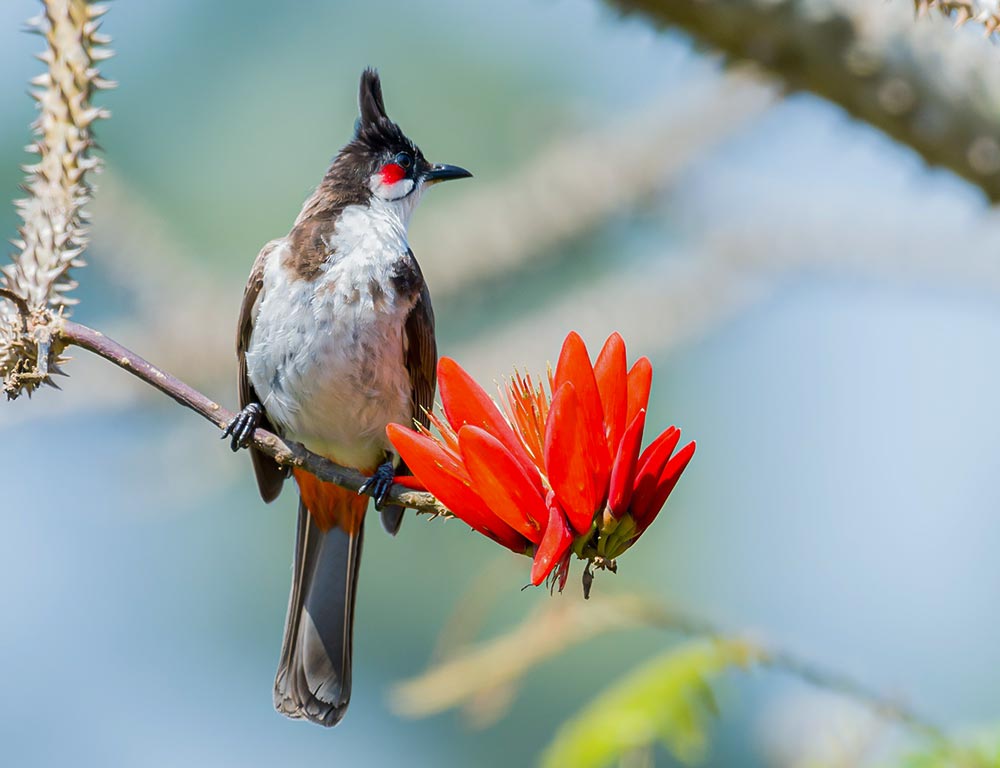
- Scientific Name: Pycnonotus jocosus
- Population: Introduced
- Life Span: 7-10 years
- Size: 8-9 inches
- Weight: 1.5-2 ounces
- Wingspan: 11-12 inches
- Status: Introduced
The Red-whiskered Bulbul (Pycnonotus jocosus) is an introduced bird species in Hawaii, known for its distinctive call and vibrant plumage.
With an established population, these bulbuls are commonly found in various habitats, including gardens, parks, and wooded areas.
Measuring between 8 to 9 inches in length and weighing between 1.5 to 2 ounces, Red-whiskered Bulbuls are medium-sized birds with a brownish body, a red patch behind the eye, and prominent red “whiskers.” Their wingspan ranges from 11 to 12 inches.
Red-whiskered Bulbuls have an omnivorous diet, feeding on fruits, insects, and nectar. They are known for their lively and melodious calls.
With a lifespan of 7 to 10 years, these introduced birds have adapted well to the Hawaiian environment, contributing to the diverse birdlife in the region.
11. Rose-ringed Parakeet
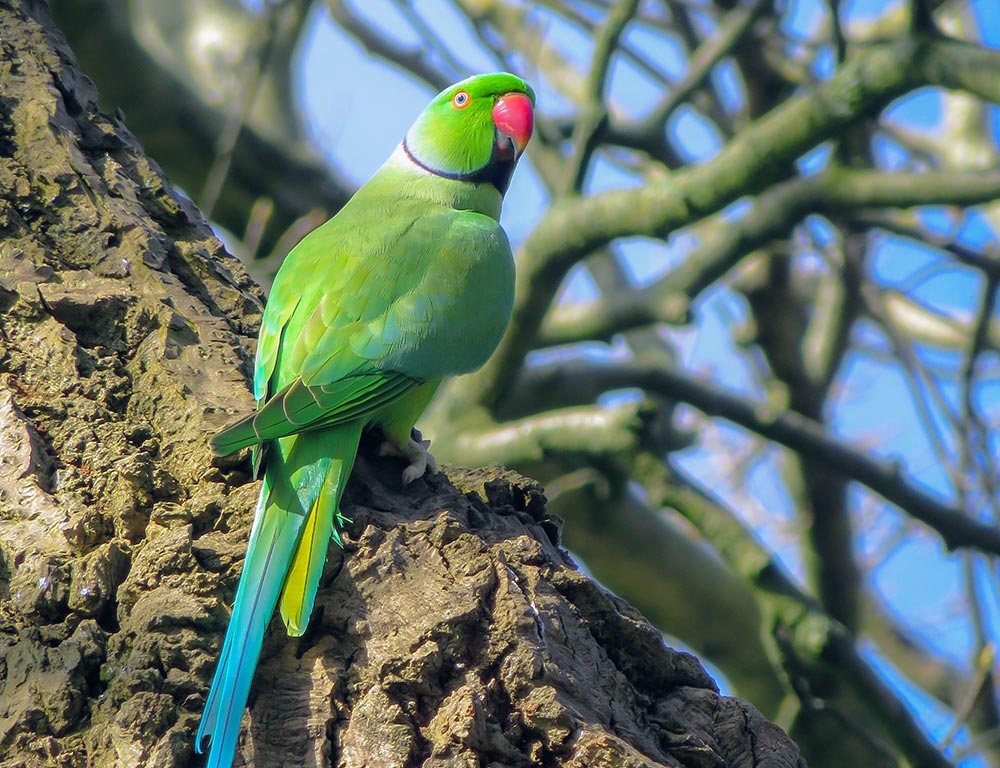
- Scientific Name: Psittacula krameri
- Population: Introduced
- Life Span: 20-30 years
- Size: 13-16 inches
- Weight: 3-5 ounces
- Wingspan: 16-18 inches
- Status: Introduced
The Rose-ringed Parakeet (Psittacula krameri) is a newly introduced bird species in Hawaii, recognized for its vibrant colors and sociable behavior. With an established population, these parakeets are commonly found in urban areas, gardens, and parks.
Measuring between 13 to 16 inches in length and weighing between 3 to 5 ounces, Rose-ringed Parakeets are medium-sized birds with predominantly green plumage, a rose-colored collar, and a long tail. Their wingspan ranges from 16 to 18 inches.
Rose-ringed Parakeets are known for their intelligence, vocalizations, and social interactions. They feed on a variety of fruits, seeds, and nuts.
With a lifespan of 20 to 30 years, these introduced parakeets have become a distinctive and lively part of Hawaii’s avian landscape, adding a touch of tropical flair to the local birdlife.
12. Northern Mockingbird
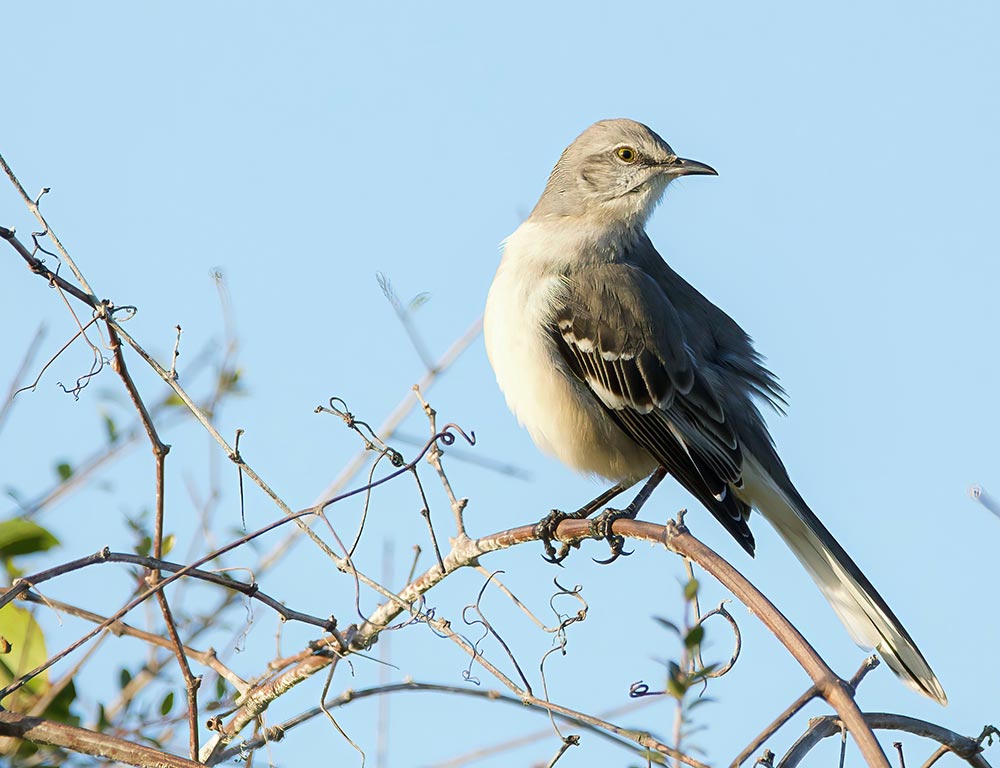
- Scientific Name: Mimus polyglottos
- Population: Introduced
- Life Span: 8-10 years
- Size: 9-11 inches
- Weight: 1.6-2 ounces
- Wingspan: 12-15 inches
- Status: Introduced
The Northern Mockingbird (Mimus polyglottos) is an introduced bird species in Hawaii, known for its exceptional vocal mimicry and adaptability.
With an established population, these mockingbirds are commonly found in various habitats, including gardens, parks, and urban areas.
Measuring between 9 to 11 inches in length and weighing between 1.6 to 2 ounces, Northern Mockingbirds are medium-sized birds with grayish-brown plumage, long tails, and white wing patches that become noticeable in flight. Their wingspan ranges from 12 to 15 inches.
Northern Mockingbirds are celebrated for their ability to imitate the songs of other birds and even mechanical sounds.
They primarily feed on insects, fruits, and berries. With a lifespan of 8 to 10 years, these introduced birds have adapted well to the Hawaiian environment, contributing their melodious tunes to the local soundscape.
13. Chestnut Munia
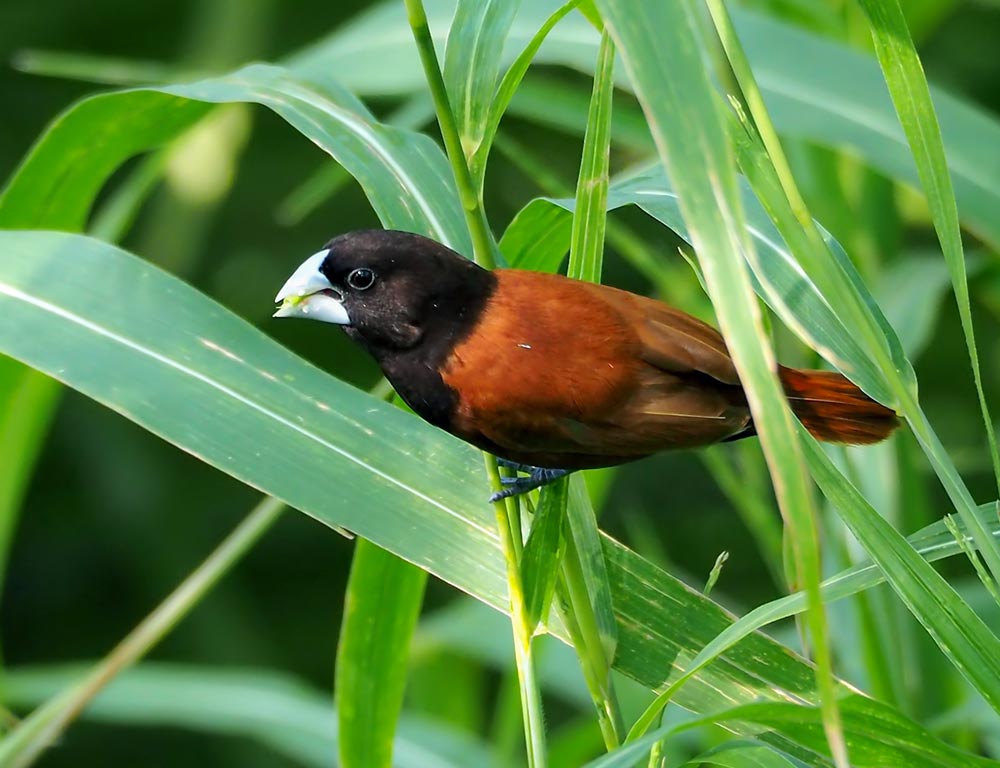
- Scientific Name: Lonchura atricapilla
- Population: Established
- Life Span: 5-7 years
- Size: 4-5 inches
- Weight: 0.6-0.8 ounces
- Wingspan: 6-7 inches
- Status: Introduced
The Chestnut Munia (Lonchura atricapilla) is an established bird species in Hawaii, having been introduced to the islands.
With a population that has successfully adapted to the local environment, these munias are commonly found in grasslands, agricultural areas, and open habitats.
Measuring between 4 and 5 inches in length and weighing between 0.6 and 0.8 ounces, Chestnut Munias are small birds with a chestnut-brown crown, black face mask, and a distinctive white belly. Their wingspan ranges from 6 to 7 inches.
Chestnut Munias primarily feed on seeds, grains, and small insects. They are often seen in flocks, foraging on the ground for their food. With a 5 to 7 years lifespan, these introduced munias have become a part of the diverse avian community in Hawaii.
14. Warbling White-eye
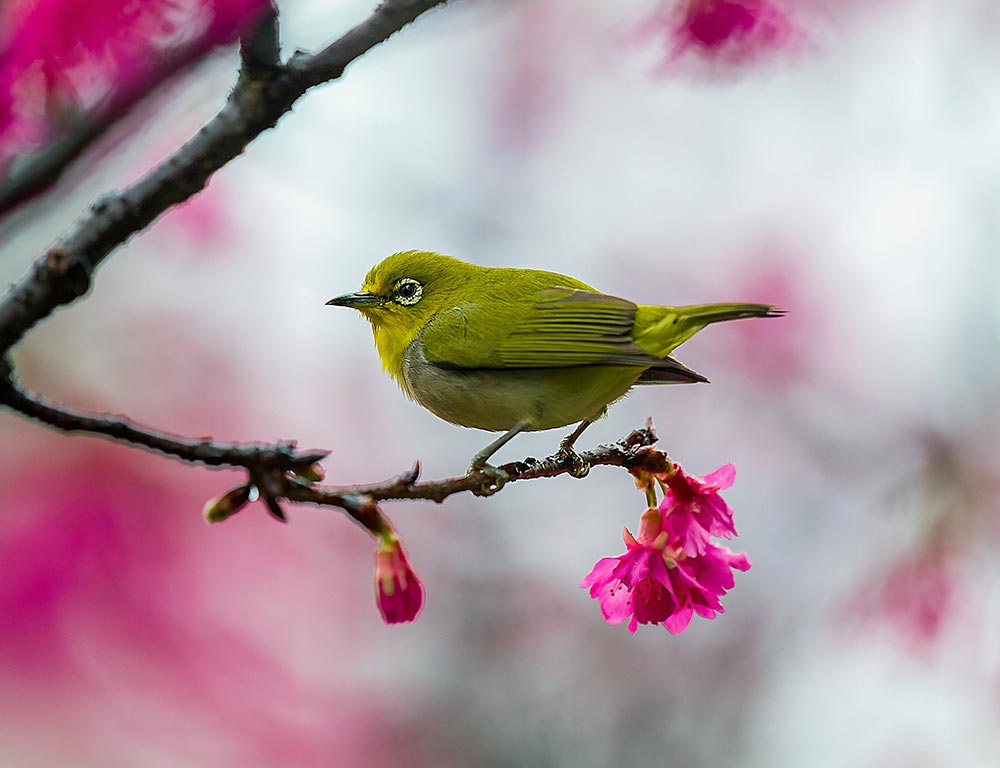
- Scientific Name: Zosterops japonicus
- Population: Native
- Life Span: 5-7 years
- Size: 4-5 inches
- Weight: 0.3-0.4 ounces
- Wingspan: 6-7 inches
- Status: Native
The Warbling White-eye (Zosterops japonicus) is a native bird species in Hawaii, known for its small size and distinctive white-eye ring. With a stable population, these white-eyes are commonly found in various habitats, including forests, gardens, and urban areas.
Measuring between 4 and 5 inches in length and weighing between 0.3 and 0.4 ounces, Warbling White-eyes are small, agile birds with greenish-yellow plumage and a conspicuous white ring around their eyes. Their wingspan ranges from 6 to 7 inches.
Warbling White-eyes primarily feed on nectar, insects, and fruits. They are known for their cheerful and melodious calls.
With a lifespan of 5 to 7 years, these native white-eyes play a crucial role in pollination and seed dispersal, contributing to the ecological balance of Hawaii’s ecosystems.
15. Scaly-breasted Munia
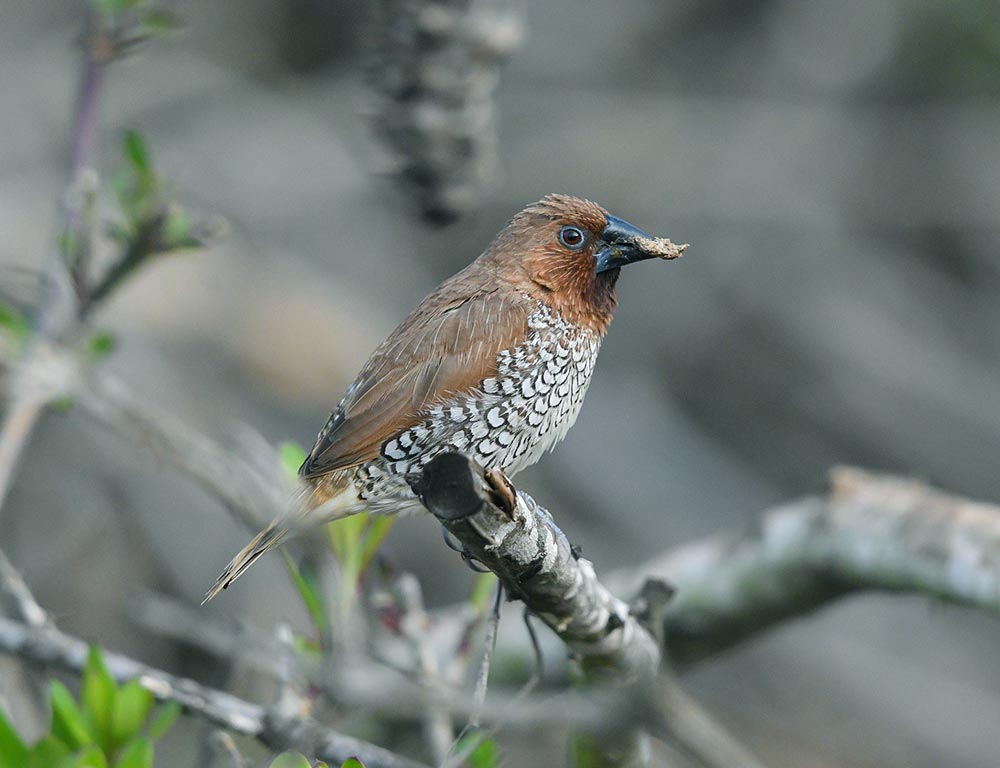
- Scientific Name: Lonchura punctulata
- Population: Established
- Life Span: 5-7 years
- Size: 4-5 inches
- Weight: 0.6-0.8 ounces
- Wingspan: 6-7 inches
- Status: Introduced
The Scaly-breasted Munia (Lonchura punctulata) is an established bird species in Hawaii, having been introduced to the islands. With a population that has successfully adapted to the local environment, these munias are commonly found in grasslands, agricultural areas, and open habitats.
Measuring between 4 to 5 inches in length and weighing between 0.6 to 0.8 ounces, Scaly-breasted Munias are small birds with a distinctive scaly pattern on their breast and brownish-gray plumage. Their wingspan ranges from 6 to 7 inches.
Scaly-breasted Munias primarily feed on seeds, grains, and small insects. They are often seen in flocks, foraging on the ground for their food. With a 5 to 7 years lifespan, these introduced munias contribute to the diverse avian community in Hawaii.
16. Grey Francolin
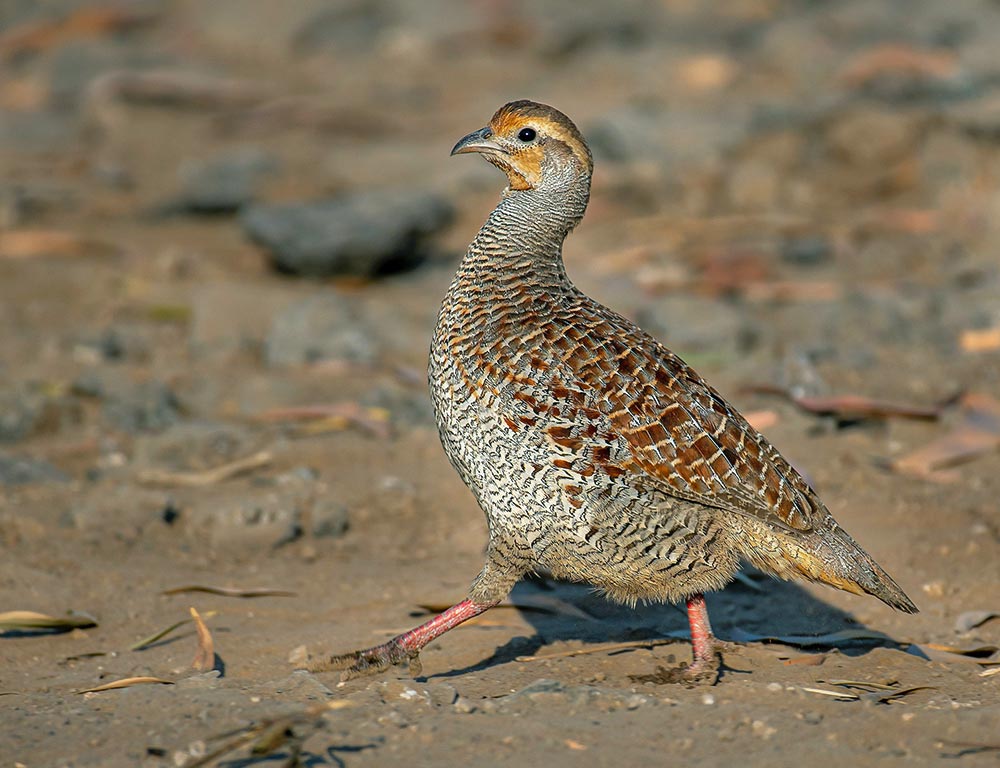
- Scientific Name: Francolinus pondicerianus
- Population: Introduced
- Life Span: 3-5 years
- Size: 12-14 inches
- Weight: 14-18 ounces
- Wingspan: 16-18 inches
- Status: Introduced
The Grey Francolin (Francolinus pondicerianus) is an introduced bird species in Hawaii, known for its ground-dwelling habits and distinctive calls. With an established population, these francolins are commonly found in grasslands, agricultural areas, and open habitats.
Measuring between 12 to 14 inches in length and weighing between 14 to 18 ounces, Grey Francolins are medium-sized birds with mottled gray and brown plumage, a distinctive white throat patch, and a red beak. Their wingspan ranges from 16 to 18 inches.
Grey Francolins primarily feed on seeds, grains, and small invertebrates. They are often seen foraging on the ground and have adapted well to various environments. With a 3 to 5 years lifespan, these introduced birds contribute to the terrestrial birdlife in Hawaii.
17. California Quail
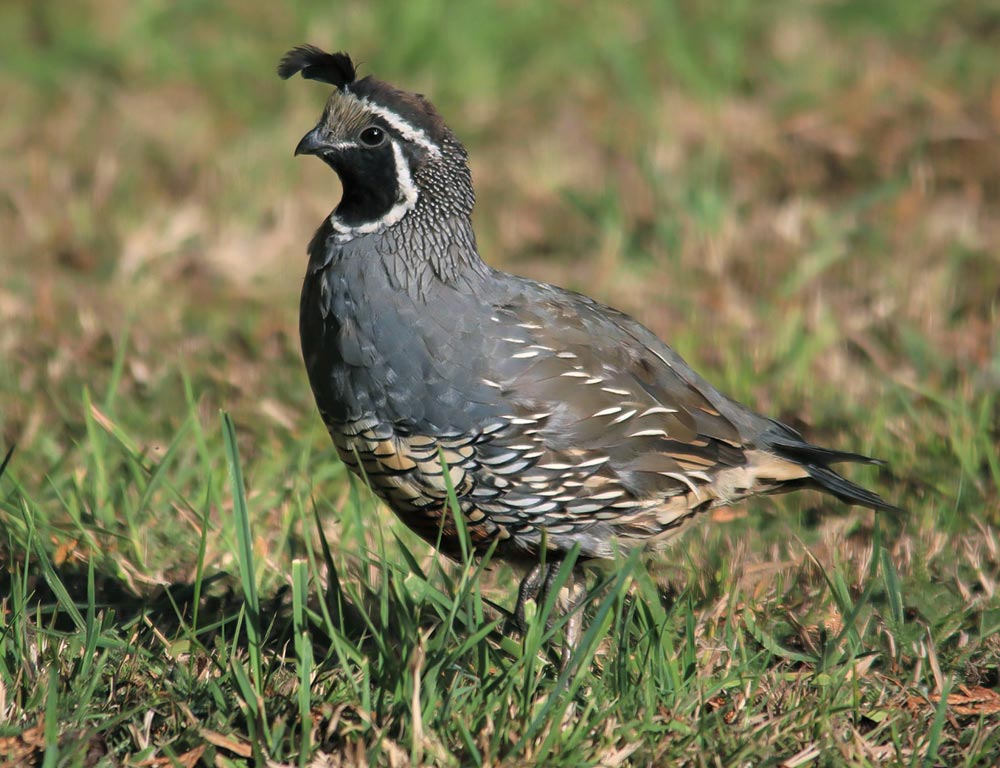
- Scientific Name: Callipepla californica
- Population: Introduced
- Life Span: 1-3 years
- Size: 9-11 inches
- Weight: 6-7 ounces
- Wingspan: 10-12 inches
- Status: Introduced
The California Quail (Callipepla californica) is a bird species introduced in Hawaii and is known for its distinctive appearance and social behavior. With an established population, these quails are commonly found in various habitats, including grasslands, open woodlands, and suburban areas.
Measuring 9 to 11 inches in length and weighing 6 to 7 ounces, California Quails are small, plump birds with a distinctive forward-curling black plume on their heads and a scaly appearance on their belly. Their wingspan ranges from 10 to 12 inches.
California Quails primarily feed on seeds, fruits, and insects. They are often seen in family groups, foraging on the ground.
With a relatively short lifespan of 1 to 3 years, these introduced quails have become a part of Hawaii’s avian diversity, contributing to the eclectic mix of bird species in the region.
Wrapping Up
Hawaii’s backyard birds showcase a harmonious coexistence of native and introduced species, each contributing to the islands’ vibrant avian tapestry.
From the melodious tunes of the Northern Mockingbird to the vibrant plumage of the introduced Rose-ringed Parakeet, these birds reflect the adaptability and resilience required to thrive in diverse ecosystems.
Whether soaring through the skies or foraging on the ground, these feathered residents play a crucial role in maintaining the ecological balance of Hawaii’s landscapes.
Embracing both the natural and introduced elements of the avian community, the backyard birds of Hawaii create a unique and captivating spectacle for bird enthusiasts and casual observers alike. Best of luck.